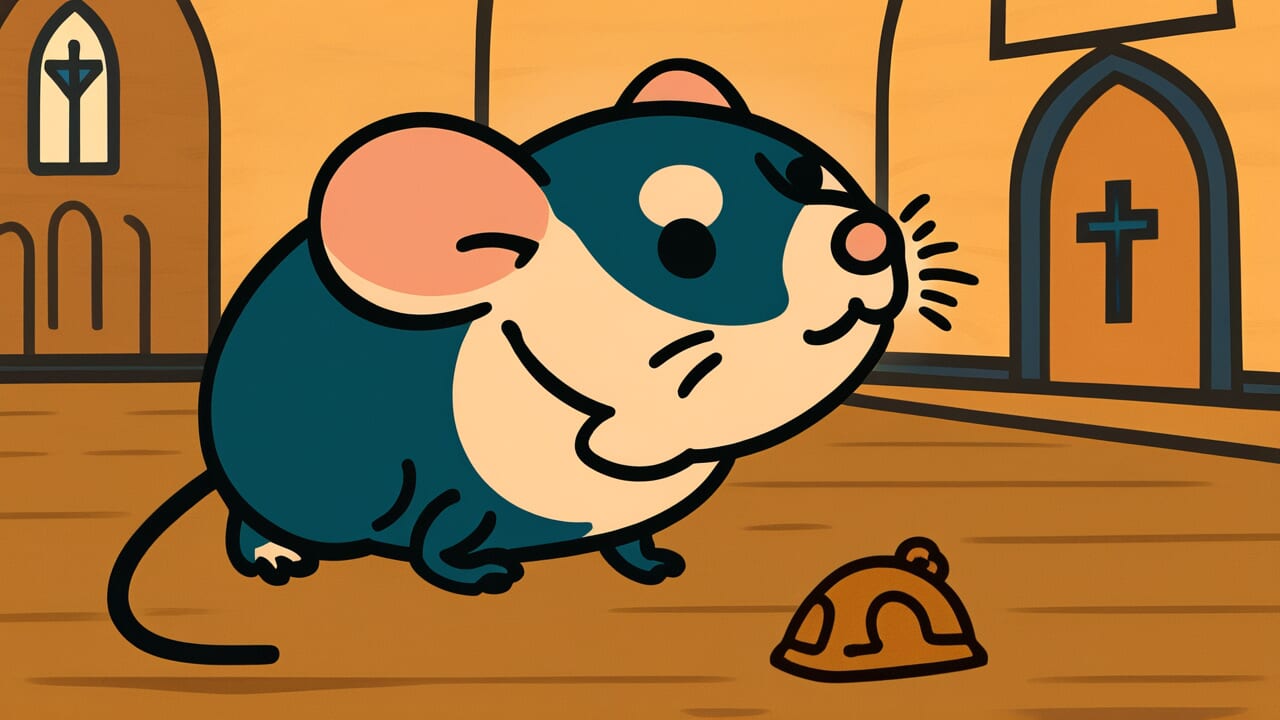How to Read “As poor as a church mouse”
As poor as a church mouse
[az POOR az uh CHURCH mowz]
All words are common and easy to pronounce.
Meaning of “As poor as a church mouse”
Simply put, this proverb means having almost no money or possessions at all.
The saying compares someone’s poverty to a mouse living in a church. Churches traditionally don’t store food like homes or shops do. A mouse in a church would struggle to find crumbs or scraps. This creates a picture of extreme need and emptiness.
We use this phrase today when someone has very little money. It describes people who can barely afford basic needs like food or shelter. You might hear it when someone loses their job or faces unexpected bills. The saying emphasizes just how little someone has left.
What makes this comparison interesting is how it uses a tiny creature in an empty place. The image helps us understand true poverty isn’t just having less money. It’s about having almost nothing at all to survive on.
Origin and Etymology
The exact origin is unknown, but similar phrases appeared in English writing several centuries ago. Early versions compared poverty to various animals in places with little food. Churches became the standard comparison because they were familiar to most people.
During medieval times, churches were central to community life. People understood that churches focused on spiritual rather than material needs. Unlike homes, shops, or barns, churches didn’t typically store food or grain. This made them perfect symbols of places where even small creatures would find nothing.
The phrase spread through everyday speech before appearing in written works. Like many folk sayings, it traveled from person to person through conversation. Over time, the church mouse version became the most common way to express this idea. The saying remained popular because the image was both clear and memorable.
Interesting Facts
The word “poor” comes from Latin “pauper,” meaning having little or nothing. This connects to other English words like “pauper” and “poverty.” The comparison uses alliteration with “poor” and creates a memorable sound pattern.
Churches in earlier times often had problems with mice, just like other buildings. However, mice in churches faced unique challenges finding food compared to those in kitchens or grain stores. This real-world observation helped make the comparison feel accurate to people who heard it.
Usage Examples
- Grandmother to granddaughter: “Don’t expect much from your cousin’s wedding gift – he’s as poor as a church mouse.”
- Coworker to colleague: “She always brings lunch from home because she’s as poor as a church mouse.”
Universal Wisdom
This proverb reveals something fundamental about how humans understand and communicate about hardship. We naturally use comparisons to make abstract concepts like poverty feel real and immediate. The image of a hungry mouse in an empty building creates instant understanding across different backgrounds and experiences.
The saying also reflects our deep awareness that survival depends on access to resources. Throughout human history, people have observed how location determines opportunity. A creature in the wrong place faces unnecessary struggle, just as people in difficult circumstances may find fewer chances to improve their situation. This observation appears in wisdom across cultures because it reflects a basic truth about survival.
What makes this particular comparison endure is how it captures the loneliness of poverty alongside the material lack. A church mouse isn’t just hungry – it’s isolated in a place meant for higher purposes. This mirrors how financial hardship often creates social isolation. People facing poverty may feel disconnected from others who have more resources. The proverb acknowledges both the practical and emotional aspects of having very little, showing how our ancestors understood poverty as more than just missing money.
When AI Hears This
Humans carefully choose poverty comparisons to create just the right emotional response. They avoid references that might make people too uncomfortable or guilty. A starving child would be too harsh and demanding. A lazy beggar might seem deserving of poverty. But a church mouse hits the perfect note. It creates sympathy without creating obligation to act.
This reveals how humans manage their feelings about inequality around them. They need metaphors that acknowledge poverty exists without making them feel responsible. The church mouse works because it seems naturally poor by circumstance. Churches have little food lying around for mice to find. This makes the poverty feel inevitable rather than fixable by human action.
What fascinates me is how this emotional calibration actually serves society well. These carefully chosen metaphors let people discuss hardship without becoming overwhelmed by guilt. They can acknowledge poverty while maintaining their psychological balance. This might seem cold, but it allows sustained compassion rather than emotional burnout. Humans have unconsciously engineered language that protects their ability to care long-term.
Lessons for Today
Understanding this wisdom helps us recognize that poverty involves more than just lacking money. True hardship often means being in situations where opportunities are scarce, much like the mouse in an environment that can’t support its basic needs. This awareness can guide how we think about helping others and improving circumstances.
In relationships and communities, this insight reminds us that people’s struggles often connect to their environment and available resources. Someone might work hard but still face difficulties if they lack access to opportunities. Recognizing this can lead to more understanding responses and practical support rather than simple judgment about individual choices.
The deeper lesson involves seeing how circumstances shape outcomes. Just as the church mouse’s location creates its poverty, people’s situations often influence their possibilities more than we initially realize. This doesn’t mean individuals have no control, but it suggests that changing circumstances sometimes matters more than changing behavior. Understanding this balance helps create more realistic and compassionate approaches to addressing hardship in ourselves and others.



Comments